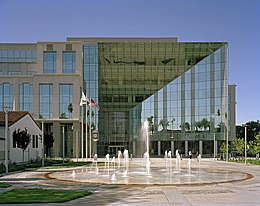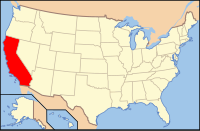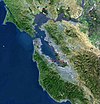Solano County, California
County of Solano | |
|---|---|
 The Solano County Government Center in Downtown Fairfield | |
 Location in the state of California | |
 California's location in the United States | |
| Country | United States |
| State | California |
| Region/Metro area | San Francisco Bay Area |
| Incorporated | 1850 |
| County seat | Fairfield |
| Largest city | Vallejo |
| Area | |
• Total | 906.67 sq mi (2,348.3 km2) |
| • Land | 829.19 sq mi (2,147.6 km2) |
| • Water | 77.48 sq mi (200.7 km2) |
| Population (2010) | 413,344 |
| • Density | 487/sq mi (188/km2) |
| Time zone | UTC-8 (Pacific Standard Time) |
| • Summer (DST) | UTC-7 (Pacific Daylight Time) |
| Website | www.co.solano.ca.us |
Solano County is a county located in Bay-Delta region of the U.S. state of California, about halfway between San Francisco and Sacramento and is one of the nine San Francisco Bay Area counties. As of 2000 its population was 394,542.[1] The county's population was estimated by the U.S. Census to be 413,344 in 2010. The county seat is Fairfield and the largest city is Vallejo.
History
Solano County was one of the original counties of California, created in 1850 at the time of statehood. Prior to statehood, it had been referred to as Benicia County.[citation needed]
At the request of General Mariano Vallejo, the county derives its name directly from an Indian Chief, Chief Solano of the Suisunes, a Native American tribe of the region and Vallejo's close ally. Chief Solano at one time led the tribes between the Petaluma River and the Sacramento River. The chief was also called Sem-Yeto, which signifies "brave or fierce hand." The Chief was given the Spanish name Francisco Solano during baptism at the Catholic Mission, and is named after the Spanish Franciscan missionary, Father Francisco Solano. "Solano" is a common surname in the north of Spain, specially in Navarra, Zaragoza and La Rioja.
Travis Air Force Base is located just east of Fairfield. CIERA.
Geography
According to the 2000 census, the county has a total area of 906.67 square miles (2,348.3 km2), of which 829.19 square miles (2,147.6 km2) (or 91.45%) is land and 77.48 square miles (200.7 km2) (or 8.55%) is water.[2]
A portion of the South Campus at the University of California, Davis is in Solano County.
Cities and towns
Unincorporated communities
- Bahia
- Birds Landing
- Bucktown - within or just outside of NW Vacaville.
- Collinsville
- Cordelia - located within the city limits of Fairfield.
- Elmira
- Green Valley
- Maine Prairie
- Scandia - The name “Scandia” is part of the cultural landscape of Solano County. It means “Little Norway,” and refers to the Scandinavian pioneers who settled the area southeast of present-day Fairfield. In 1852, three Norwegian seafarers – Carl H. Thompson and his brother Dan, and Steve Larsen – purchased a small sailboat in San Francisco and headed up the Sacramento River. Apparently their destination was the gold fields of the Mother Lode region; however, they missed the main channel of the river and found themselves in Montezuma Slough which is located a few miles south of present-day Travis Air Force Base (AFB). They abandoned their boat there and walked inland to Calaveras County. After two years of work, and finding little gold, the three Norwegians returned to Montezuma Slough, built a small house, and raised sheep and cattle. Gradually other Scandinavians took up farming in the area, and ‘Little Norway’ became the accepted name of the area east and south of Denverton.
Adjacent counties
- Contra Costa County, California - south
- Sonoma County, California - west
- Napa County, California - west
- Yolo County, California - north
- Sacramento County, California - east
National protected area
Environment
Endangered species
Solano county has a number of rare and endangered species including the beetle Elaphrus viridis, the wildflower Lasthenia conjugens, commonly known as Contra Costa goldfields and the annual plant Legenere limosa or False Venus' looking glass.
Solano County has several inactive cinnabar mines including the Hastings Mine and St. John's Mine,[3] both of which are subject to ongoing environmental monitoring; these mines were worked in the first half of the twentieth century.
Transportation infrastructure
Major highways
 Interstate 80
Interstate 80 Interstate 505
Interstate 505 Interstate 680
Interstate 680 Interstate 780
Interstate 780 State Route 12
State Route 12 State Route 29
State Route 29 State Route 37
State Route 37 State Route 84
State Route 84 State Route 113
State Route 113
Public transportation
Solano County is served by several transit agencies:
- Vallejo Transit, which also operates the Baylink Ferry to San Francisco
- Fairfield Suisun Transit
- Benicia Breeze
- Vacaville City Coach
- Rio Vista Delta Breeze
Each agency interconnects with each other, enabling transit trips throughout the county. Service also connects with BART stations in Contra Costa County. Transit links are provided to Napa, Yolo and Sacramento counties as well.
Greyhound and Amtrak provide long-distance intercity service.
Airports
General aviation airports in Solano County which are open to the public are the Nut Tree Airport and Rio Vista Municipal Airport.
Demographics
| Census | Pop. | Note | %± |
|---|---|---|---|
| 1850 | 580 | — | |
| 1860 | 7,169 | 1,136.0% | |
| 1870 | 16,871 | 135.3% | |
| 1880 | 18,475 | 9.5% | |
| 1890 | 20,946 | 13.4% | |
| 1900 | 24,143 | 15.3% | |
| 1910 | 27,559 | 14.1% | |
| 1920 | 40,602 | 47.3% | |
| 1930 | 40,834 | 0.6% | |
| 1940 | 49,118 | 20.3% | |
| 1950 | 104,833 | 113.4% | |
| 1960 | 134,597 | 28.4% | |
| 1970 | 169,941 | 26.3% | |
| 1980 | 235,203 | 38.4% | |
| 1990 | 340,421 | 44.7% | |
| 2000 | 394,542 | 15.9% | |
| 2010 | 413,344 | 4.8% |
As of the censusTemplate:GR of 2000, there were 394,542 people, 130,403 households, and 97,411 families residing in the county. The population density was 476 people per square mile (184/km²). There were 134,513 housing units at an average density of 162 per square mile (63/km²). The racial makeup of the county in 2010 was 40.8% non-Hispanic White, 14.2% non-Hispanic Black or African American, 0.5% Native American, 14.3% Asian, 0.8% Pacific Islander, 0.4% from other races, and 5.1% from two or more races. 24.0% of the population were Hispanic or Latino of any race. 8.5% were of German, 6.4% Irish and 6.0% English ancestry according to Census 2000. 75.7% spoke English, 12.1% Spanish and 6.6% Tagalog as their first language.
There were 130,403 households out of which 39.90% had children under the age of 18 living with them, 55.70% were married couples living together, 13.80% had a female householder with no husband present, and 25.30% were non-families. 19.60% of all households were made up of individuals and 6.50% had someone living alone who was 65 years of age or older. The average household size was 2.90 and the average family size was 3.33.
In the county the population was spread out with 28.30% under the age of 18, 9.20% from 18 to 24, 31.30% from 25 to 44, 21.70% from 45 to 64, and 9.50% who were 65 years of age or older. The median age was 34 years. For every 100 females there were 101.50 males. For every 100 females age 18 and over, there were 100.20 males.
The median income for a household in the county was $54,099, and the median income for a family was $60,597. Males had a median income of $41,787 versus $31,916 for females. The per capita income for the county was $21,731. About 6.10% of families and 8.30% of the population were below the poverty line, including 10.30% of those under age 18 and 6.30% of those age 65 or over.
Politics
| Year | GOP | DEM | Others |
|---|---|---|---|
| 2008 | 34.9% 56,035 | 63.5% 102,095 | 2.1% 3,458 |
| 2004 | 41.9% 62,301 | 57.2% 85,096 | 1.0% 1,440 |
| 2000 | 39.2% 51,604 | 57.0% 75,116 | 3.8% 5,015 |
| 1996 | 34.7% 40,742 | 55.1% 64,644 | 10.1% 11,893 |
| 1992 | 29.4% 38,883 | 48.7% 64,320 | 21.9% 28,908 |
| 1988 | 47.4% 50,314 | 51.2% 54,344 | 1.4% 1,430 |
| 1984 | 54.5% 51,678 | 44.3% 41,982 | 1.2% 1,138 |
| 1980 | 50.7% 40,919 | 38.4% 30,952 | 10.9% 8,805 |
| 1976 | 42.4% 26,136 | 54.6% 33,682 | 3.0% 1,826 |
| 1972 | 54.0% 31,314 | 42.7% 24,766 | 3.3% 1,885 |
| 1968 | 34.7% 17,683 | 53.5% 27,271 | 11.8% 5,998 |
| 1964 | 30.4% 15,263 | 69.5% 34,930 | 0.1% 47 |
| 1960 | 40.9% 18,751 | 58.8% 26,977 | 0.3% 141 |
| 1956 | 41.7% 17,865 | 58.1% 24,903 | 0.2% 95 |
| 1952 | 42.4% 19,369 | 57.2% 26,130 | 0.5% 216 |
| 1948 | 33.7% 12,345 | 63.5% 23,257 | 2.8% 1,022 |
| 1944 | 29.8% 10,361 | 69.9% 24,335 | 0.3% 105 |
| 1940 | 28.5% 6,081 | 70.6% 15,054 | 0.9% 193 |
| 1936 | 20.9% 3,603 | 78.1% 13,459 | 1.1% 182 |
| 1932 | 30.3% 4,382 | 67.2% 9,712 | 2.5% 367 |
| 1928 | 52.3% 7,061 | 46.5% 6,278 | 1.2% 158 |
| 1924 | 48.0% 4,782 | 9.6% 957 | 42.4% 4,223 |
| 1920 | 64.8% 7,102 | 26.9% 2,954 | 8.3% 909 |
Solano is a strongly Democratic county in presidential and congressional elections, though it usually gives somewhat higher vote percentages to Republicans compared to the eight other Bay Area counties. The last Republican to win a majority in the county was Ronald Reagan in 1984.
Solano is part of California's 3rd, 7th, and 10th congressional districts. The 3rd is represented by Republican Dan Lungren and the 7th by Democrat George Miller. The 10th has been vacant since Ellen Tauscher was appointed to be Undersecretary of State, and was filled in a special election on November 3, 2009 by Democrat John Garamendi. In the State Assembly Solano is in the 7th and 8th Assembly districts, which are held by Democrats Michael Allen and Mariko Yamada, respectively. In the California State Senate, Solano is part of the 2nd and 5th Senate districts, which are held by Democrats Noreen Evans and Lois Wolk, respectively.
On Nov. 4, 2008, Solano County voted 55.9% for Proposition 8, which amended the California Constitution to ban same-sex marriages. It was the only Bay Area county to approve the initiative. In the 2008 presidential election that day, Barack Obama carried the county by a 28.5% margin over John McCain, a larger margin than statewide (24%).[4]
Trivia
- In 1985 Humphrey the humpback whale strayed off his migration route and ended up in Rio Vista at which point rescuers from The Marine Mammal Center and other volunteers were able to turn him around in the narrow river channel.
See also
- Hiking trails in Solano County
- List of school districts in Solano County, California
- National Register of Historic Places listings in Solano County, California
- Solano County Library
References
- ^ United States Census Bureau : Census 2000 : Population, Housing Units, Area and Density : Solano County Retrieved 2009-11-15
- ^ "Census 2000 U.S. Gazetteer Files: Counties". United States Census. Retrieved 2011-02-13.
- ^ C.Michael Hogan, Marc Papineau et al., Environmental Assessment of the columbus Parkway Widening between Ascot Parkway and the Northgate Development, Vallejo, Earth Metrics Inc. Report 7853, California State Clearinghouse, Sept, 1989
- ^ U.S. Election Atlas



